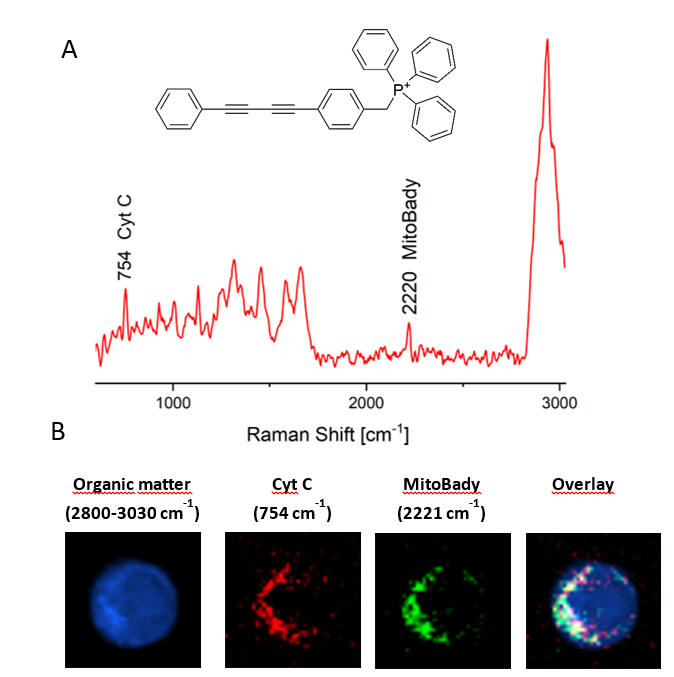The importance of choosing the right protocol for leukemia cell studies using Raman imaging
Anna Maria Nowakowska1, Aleksandra Borek-Dorosz1,2, Patrycja Leszczenko1, Adriana Adamczyk1, Anna Pieczara2, Justyna Jakubowska3, Kinga Ostrowska3, Agata Pastorczak3, Krzysztof Brzozowski1, Małgorzata Barańska1,2, Katarzyna Maria Marzec2, Katarzyna Majzner*1,2
1Jagiellonian University, Faculty of Chemistry, Krakow, Poland
2Jagiellonian University, Jagiellonian Centre for Experimental Therapeutics (JCET), Krakow, Poland
3Medical University of Łódź, Department of Pediatrics, Oncology and Hematology, Łódź, Poland
Leukemias are a very heterogeneous group of blood cancers. Different types of leukemia can be distinguished depending on specific mutations causing malignancy. Razing correct diagnosis is crucial in order to apply the appropriate treatment. Nowadays, diagnostic tests are based mainly on the assessment of the morphology of bone marrow cells. It is also believed that Raman spectroscopy could be an efficient technique supporting the rapid diagnosis of leukemia due to high chemical sensitivity. In routine clinical practice, blood or bone marrow cells collected from patients are subjected to multiple external factors that influence its quality and resulting from the collection, transporting and storage. Therefore, analysis of living cells is not always possible and studies of fixed cells are necessary. Due to the high sensitivity of Raman spectroscopy, sample preparation can affect the results obtained [1–3] and the protocol of preparation should be chosen with care and optimized, particularly in the context of clinical practice [4].
In our studies, we tested the influence of GA fixation [5] at different concentrations (0.1%, 0.5% and 2.5% GA) on the molecular structure of leukemia cells (T cell acute lymphoblastic leukemia (T-ALL)) and normal peripheral blood mononuclear cells (PBMCs) with the use of Raman micro-imaging. The aim of our studies was to identify the most optimal concentration of GA in order to detect spectral markers related to oncogenesis in the future. Results of our studies show a change in the protein secondary structure manifested by the increase of the intensity of the band at 1041 cm-1, characteristic for phenylalanine [5,6] in spectra of cells fixed with higher GA concentration. GA at a concentration of 0.5% was showed to be the most optimal in fixing both normal and cancer cells. We also tested the chemical stability of fixed cells within 11 days of storage. 0.1% concentration of GA was found to be insufficient to preserve the molecular structure of PBMCs over time. In order to store cells and ensure their high survival rate, banking in the vapor phase of the liquid nitrogen is used. In our studies, we tested the influence of preculturing of cells for 72h after thawing. In the case of cells fixed with 0.5% GA, no significant impact was detected on spectral profiles of T-ALL cells. Our results show that chemical procedures applied in the preparation of cells may affect Raman spectra and influence the identification of spectroscopic markers characteristic for different subtypes of leukemia.
The „Label-free and rapid optical imaging, detection and sorting of leukemia cells” project is carried out within the Team-Net programme of the Foundation for Polish Science co-financed by the EU.
[1] A.J. Hobro, N.I. Smith, Vib. Spectrosc. 91 (2017) 31–45. https://doi.org/10.1016/j.vibspec.2016.10.012.
[2] A.D. Meade, C. Clarke, F. Draux, G.D. Sockalingum, M. Manfait, F.M. Lyng, H.J. Byrne, Anal. Bioanal. Chem. 396 (2010) 1781–1791. https://doi.org/10.1007/s00216-009-3411-7.
[3] E. Gazi, J. Dwyer, N.P. Lockyer, J. Miyan, P. Gardner, C. Hart, M. Brown, N.W. Clarke, Biopolymers. 77 (2005) 18–30. https://doi.org/10.1002/bip.20167.
[4] N. Chaudhary, T.N. Que Nguyen, A. Maguire, C. Wynne, A.D. Meade, Anal. Methods. (2021) 1019–1032. https://doi.org/10.1039/d0ay02040k.
[5] E. Bik, A. Dorosz, L. Mateuszuk, M. Baranska, K. Majzner, Spectrochim. Acta - Part A Mol. Biomol. Spectrosc. 240 (2020) 118460. https://doi.org/10.1016/j.saa.2020.118460.
[6] B. Hernández, F. Pflüger, S.G. Kruglik, M. Ghomi, J. Raman Spectrosc. 44 (2013) 827–833. https://doi.org/10.1002/jrs.4290.
Form: oral presentation
więcej o

